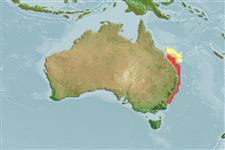Issue
This species is placed in the genus Epinephelus Bloch, 1793 in Eschmeyer (CofF ver. May 2011: Ref. 86870).
Environment: milieu / climate zone / depth range / distribution range
экология
морской демерсальный; пределы глубины 15 - 370 m (Ref. 5222). Subtropical; 18°S - 36°S, 150°E - 155°E (Ref. 5222)
Southwest Pacific: off the eastern coast of Australia.
Size / Вес / Возраст
Maturity: Lm ? range ? - ? cm
Max length : 157 cm TL самец/пол неопределен; (Ref. 5222); наибольший вес (опубликованные данные): 66.0 kg (Ref. 5222)
колючие лучи спинного плавника (общее число) : 11; членистые (мягкие) лучи спинного плавника (общее число) : 14 - 15; колючие лучи анального плавника: 3; членистые (мягкие) лучи анального плавника: 9 - 10. Distinguished by the following characteristics: juveniles, pale brown with 7 broad dark bars, last covering most of caudal peduncle, upper half is black; prominent black maxillary streak; dark brown median and pelvic fins; translucent pectoral fins; adults pinkish gray in color, with or without dark bars; fins darker than body with white margins; depth of body contained 2.6-2.9 times in SL; head length 2.4-2.6 times in SL; slightly convex interorbital area and dorsal head profile; subangular preopercle, finely serrate, serrae on rounded corner not enlarged and ventral edge with 1-4 small serrae; almost straight upper edge of operculum; posterior nostrils 2-4 times larger than anterior nostrils; maxilla reaching almost to vertical at rear edge of eye; 2 rows of small teeth on midlateral part of lower jaw (Ref. 89707).
Found on the continental shelf and continental slope (Ref. 75154). Inhabits rocky reefs (Ref. 89707). Juveniles are found at depths between 15 and 128 m. Occurrence at lesser depths in the south off New South Wales is probably related to the cooler sea temperature.
Life cycle and mating behavior
половая зрелость | размножение | нерест | икра | Fecundity | личинки
Craig, M.T. and P.A. Hastings, 2007. A molecular phylogeny of the groupers of the subfamily Epinephelinae (Serranidae) with revised classification of the epinephelini. Ichthyol. Res. 54:1-17. (Ref. 83414)
Статус Красного Списка МСОП (Ref. 130435: Version 2024-1)
Угроза для людей
Harmless
Использование человеком
рыболовство: рыболовство как средство для существования
дополнительная информация
инструменты
Специальные отчеты
Скачать в формате XML
ресурсы в Интернет
Estimates based on models
Preferred temperature (Ref.
123201): 18.8 - 23.5, mean 20.3 °C (based on 11 cells).
Phylogenetic diversity index (Ref.
82804): PD
50 = 0.5001 [Uniqueness, from 0.5 = low to 2.0 = high].
Bayesian length-weight: a=0.01349 (0.00621 - 0.02932), b=3.03 (2.86 - 3.20), in cm total length, based on LWR estimates for this Genus-body shape (Ref.
93245).
Trophic level (Ref.
69278): 4.0 ±0.7 se; based on size and trophs of closest relatives
устойчивость к внешним воздействиям (Ref.
120179): очень низкий, минимальное время удвоения популяции более 14 лет (Preliminary K or Fecundity.).
Fishing Vulnerability (Ref.
59153): Very high vulnerability (90 of 100).
